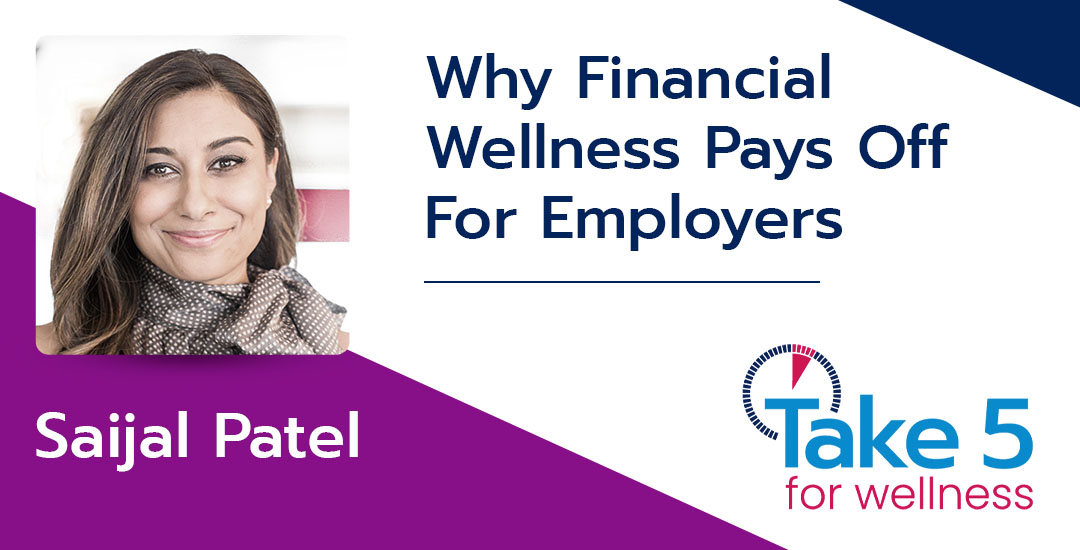When employees are financially well, employers reap the rewards of a healthier, more productive and loyal workforce, emphasizes Saijal Patel, founder and CEO of Saij Wealth Consulting and creator and host of The News Forum’s national online personal finance program, Strictly Money. In a recent webinar for The Benefits Alliance Group, the financial wellness consultant discussed why the support of financial health needs to be a workplace imperative, particularly for female staff. In a conversation with Take 5 for Health Benefits, Patel speaks more about how employers can support their employees’ financial wellness journey.
How do you define financial wellness?
According to the Organisation for Economic Co-operation and Development (OECD), financial wellness is “a state of being reflecting a person’s ability to: meet current and ongoing financial obligations; feel secure in their financial future; and make choices that allow enjoyment of life.”
What does that really mean? You should have control over your day-to-day finances. You should know where your money is coming from and where it’s going. You should have the ability to absorb a financial shock. You should have the financial freedom to make choices to enjoy life. And you should be on track to meet SMART (specific, measurable, achievable, relevant and timely) financial goals.
I’d also emphasize that financial wellness isn’t a feeling; the reality of a person’s situation matters. The only way to bridge the gap between perception and actuality is to build knowledge and skills.
What particular challenges do women face?
Women face a wage gap and an even bigger wealth gap. They save less because they make less relative to men. Due to caregiving responsibilities, they take career breaks so they contribute less to corporate and government pensions. And they’re less likely to invest compared to their male counterparts. When you take all of that into consideration, a 20 percent wage gap can easily translate into a 40 percent wealth gap. Plus, typically women live longer than men so they have to stretch out their savings.
The 2021 Financial Stress Index found that 62% of women feel stressed by their financial situation, compared to 49% of men. Everyone needs financial wellness programs – but women do most of all.
What’s the return on investment for employers that help improve employees’ financial wellness?
Believe it or not, companies can save anywhere from $5,000 to $8,000 per employee when they address financial stress and improve financial wellness. I’m pretty conservative with that estimate – I’ve seen even higher numbers.
Studies show financially well employees are 16% more productive and take about three fewer sick days every year. They make fewer claims for health benefits. They’re more likely to remain with their employer, with 80% of people in one survey saying that a financial wellness program would encourage them to stay. They’re also more likely to retire on schedule, reducing expenses related to the effective management of resources and talent.
It all adds up to a compelling return on investment.
What does a financial wellness program look like?
An effective program starts in a safe and non-judgemental environment and reflects what employees need, want and are most stressed about.
I encourage employers to use anonymous surveys to get input from employees because of the shame and stigma associated with the state of one’s finances. I also recommend bigger, almost mandatory company-wide or division-wide townhalls or webinars to reinforce the idea that everyone has financial challenges and benefits from financial wellness.
Make sure content is easy to digest, with no jargon and is relatable to aspects of employees’ lives. Mix up formats—such as townhalls, webinars, articles and other resources—to meet the needs of different learning styles. And drip content throughout the year. It’s important to remember that building healthy financial habits is a process and won’t happen with one event.
Keep in mind that you don’t have to do everything yourself. While employers are the conduit, they won’t necessarily have the expertise. Draw on government websites for neutral information and engage with third-party partners who have the financial knowledge and delivery experience. One valuable partner is your benefits plan advisor, who can support you in helping your employees achieve financial wellness.
